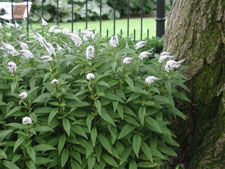Resource Library
Plant of the Week: Loosestrife, Gooseneck
The University of Arkansas System Division of Agriculture does not promote, support or recommend plants featured in "Plant of the Week." Please consult your local Extension office for plants suitable for your region.
Plant of the Week
Gooseneck Loosestrife
Latin: Lysimachia clethroides

As the Internet has taken hold, I find myself using it to get a consensus view on topics such as which movies to watch and even the merits of specific plants. Knowing most movie ratings are done by tech-savvy 15-year-olds, I always take them with a grain of salt. But when I see a high negative rating on a garden perennial I take it more seriously. Such is the case with Gooseneck Loosestrife, Lysimachia clethroides.
Gooseneck loosestrife is a 24- to 30-inch foot tall, fast-spreading, herbaceous perennial in the primrose family. It is a neat and tidy grower with lots of elliptical, mostly glabrous leaves densely crowding the erect stems. In the fall there may be a bit of yellow fall color.
From early- to mid-summer a nodding, terminal spike of white flowers is produced atop each stem. Small, individual non-fragrant flowers have five petals and are to one-quarter-inch across. When plants first flower, the spike is about 4 inches long. Later in the summer it will extend to about a foot. Plants continue flowering as long as the soil stays moist and temperatures do not get too high.
Most of the 180 Lysimachias are native to Europe or Asia. This species is widely distributed in China and Japan where it grows in moist mountain meadows, near streams and along roadways.
The Website-based public opinion poll shows a divided gardening electorate. About one-third have a negative view of gooseneck loosestrife, one-third are positive and one-third hasn’t made up its mind. Many in the neutral category have grown it for only three to four years so their opinion may become more negative over time.
Gooseneck loosestrife’s detractors uniformly condemn its invasive root system. It spreads widely by white rhizomes, especially if planted in moist, fertile soil. About 15 years ago I planted a plant in a dry, partially shaded bed where oak roots predominate; today the clump is about 6 feet across. If you don’t like, or are afraid of bamboo, then you probably should not plant gooseneck loosestrife.
This plant is hardy from zone 4 through 9 and has a decided preference for bright, rich, moist sites. Gooseneck loosestrife will grow in full sun or medium shade. Its growth rate is checked considerably by shade and summer drought. It is not well suited for inclusion in the mixed border or the small garden because of its thuggish ways. However, plants with invasive roots can be grown by containing the roots in a buried container.
On larger properties gooseneck loosestrife can be used for naturalizing along stream overflow areas or at the interface between woods and open ground. It can be used as an herbaceous groundcover in areas where its spread can be controlled by mowing or a natural barrier such as water or a walk. Its spread is only by means of its rhizomes, not by seed.
Gooseneck loosestrife should not be confused with purple loosestrife (Lythrum salicaria), the escaped ornamental that has become a common weed of waterways in the northern states. Purple loosestrife and gooseneck loosestrife, though they share a common name, are in completely different families.
By: Gerald Klingaman, retired
Extension Horticulturist - Ornamentals
Extension News - July 2, 2009
The University of Arkansas System Division of Agriculture does not maintain lists of retail outlets where these plants can be purchased. Please check your local nursery or other retail outlets to ask about the availability of these plants for your growing area.